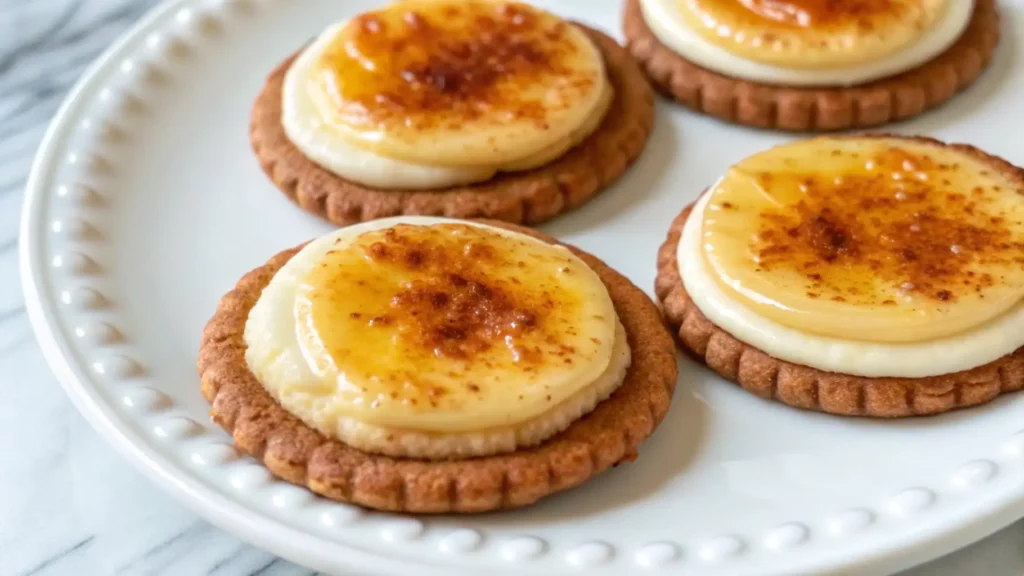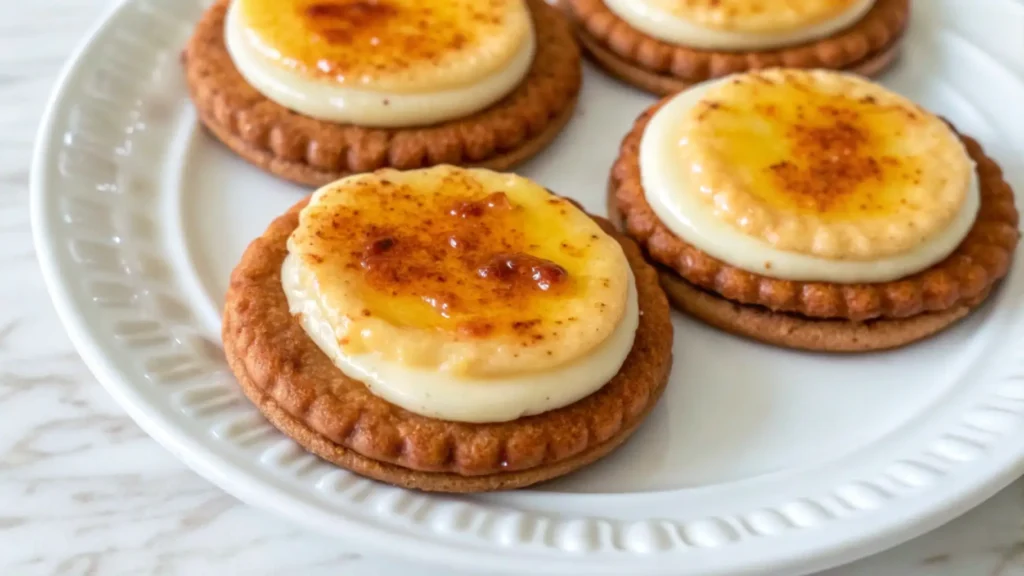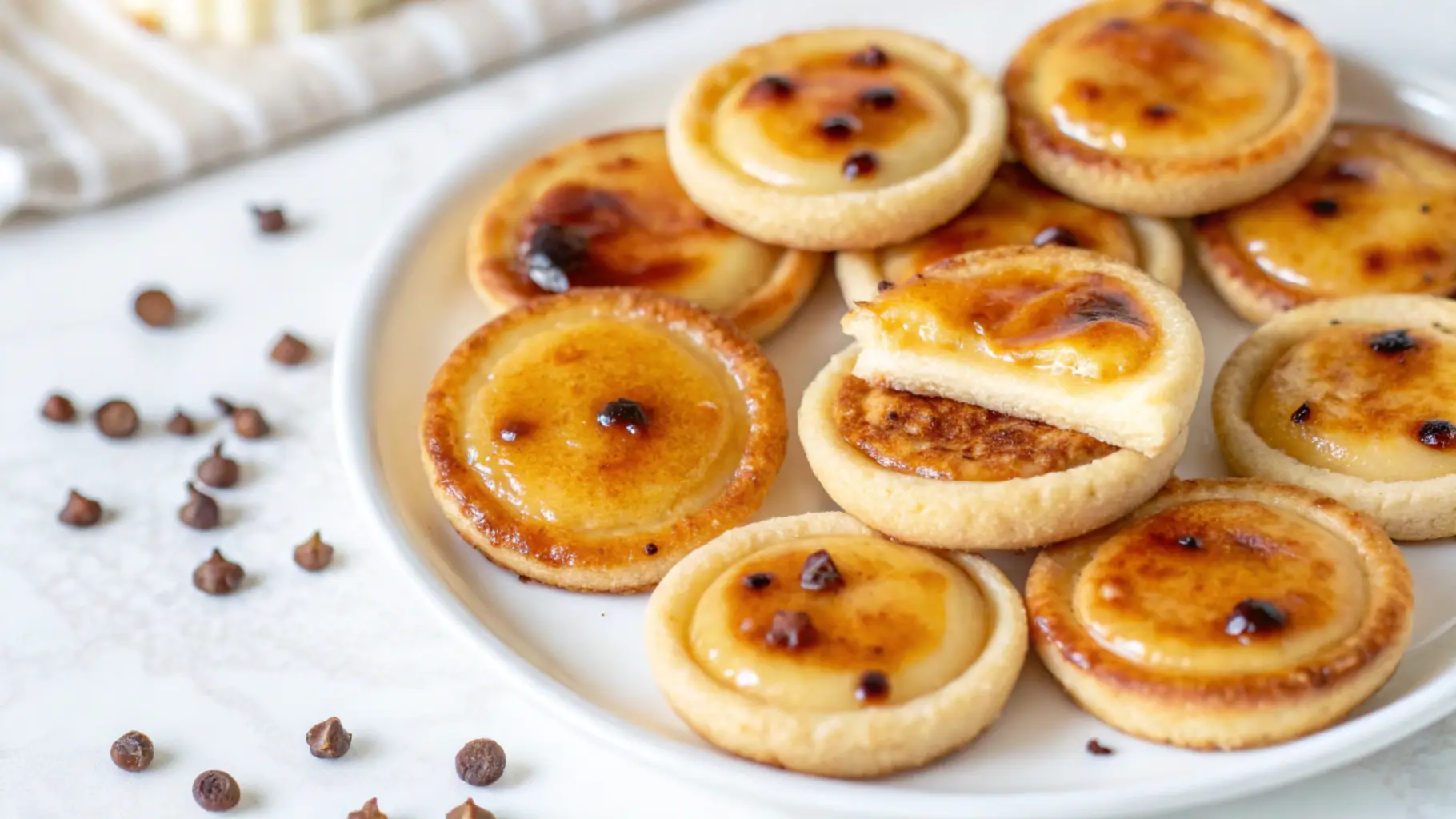Crème Brûlée Cookies: The Ultimate Guide to an Elegant Dessert Treat
What Are Crème Brûlée Cookies?
Crème Brûlée Cookies are a luxurious fusion of two beloved desserts—traditional crème brûlée and classic cookies. These treats bring the rich, creamy essence of crème brûlée into the compact, portable form of a cookie, complete with a caramelized sugar topping that cracks under your spoon (or teeth!).
By blending the buttery texture of cookies with the vanilla-infused custard flavor and iconic brûlée top, these cookies deliver a one-of-a-kind dessert experience.
The Origins of Crème Brûlée
A Brief History of Crème Brûlée
Crème brûlée, meaning “burnt cream” in French, has origins dating back to the 17th century. This indulgent dessert is traditionally made of a creamy custard base topped with a caramelized sugar crust. Though its precise origin is debated, crème brûlée gained prominence in French cuisine and later became a staple in fine dining worldwide.
Influence on Modern Desserts
The dessert’s timeless appeal has inspired many modern adaptations, including the rise of crème brûlée cookies. By incorporating the dessert’s signature elements—rich custard flavors and caramelized sugar—these cookies offer a fresh twist on a classic.
Why Are Crème Brûlée Cookies Unique?
Signature Characteristics
Crème brûlée cookies stand out due to their distinctive flavor and texture profile. They combine:
- A soft, custard-like center.
- The satisfying crunch of a caramelized top.
- The comforting warmth of vanilla and caramel.
How They Differ from Traditional Cookies
Unlike most cookies, crème brûlée cookies focus on capturing a layered experience. While chocolate chip or oatmeal cookies emphasize uniform textures, crème brûlée cookies add a dynamic interplay of creamy, crispy, and buttery sensations.
Ingredients Overview
To craft the perfect crème brûlée cookies, it’s crucial to use the right ingredients that capture their signature flavors.
Key Ingredients
- Vanilla: The heart of crème brûlée cookies, bringing depth and warmth.
- Heavy Cream: Adds richness and a custard-like quality.
- Granulated Sugar: Essential for caramelizing the brûlée topping.
- Butter and Eggs: Provide the soft, tender base typical of cookies.
- Flour: Forms the structural foundation of the dough.
Importance of Flavors
The interplay of vanilla, caramel, and cream is what defines crème brûlée cookies. Achieving the right balance of these flavors is essential for capturing the essence of the dessert.
Vanilla Beans vs. Extract: Which to Choose?
Benefits of Real Vanilla Beans
- Real vanilla beans provide an intensely aromatic flavor and those signature black specks for an artisanal look.
- They’re ideal for bakers seeking authenticity.
Budget-Friendly Alternatives
- High-quality vanilla extract or paste offers a more affordable option without sacrificing too much flavor.
- Avoid imitation vanilla, as it lacks the depth required for this sophisticated dessert.
Sugar Options for Caramelizing the Top
Types of Sugar
- Granulated Sugar: A classic choice for a crisp, uniform brûlée crust.
- Raw Sugar: Adds extra crunch and a subtle molasses flavor.
- Caster Sugar: Ideal for a delicate, even caramelization.
Tools Required
- A kitchen torch is the gold standard for achieving the perfect brûlée topping.
- For those without a torch, a broiler can serve as a viable alternative.
Tools and Equipment Needed
Creating crème brûlée cookies requires some essential tools:
- Baking Sheets and Parchment Paper: Ensure even baking and easy cleanup.
- Electric Mixer: Helps achieve a light, airy dough.
- Cookie Cutters: For consistent shapes and sizes.
Specialty Tools
- Kitchen Torch: Essential for caramelizing sugar.
- Metal Spoon or Sugar Shaker: Distributes sugar evenly over the cookie tops.
Popular Variations of Crème Brûlée Cookies
Fruit-Enhanced Flavors
- Adding raspberries, blueberries, or citrus zest introduces a refreshing contrast to the rich base.
- Citrus zest, especially orange or lemon, enhances the caramel notes.
Chocolate-Infused Variations
- Melted chocolate or cocoa powder can be incorporated for a decadent twist.
- White chocolate chips pair beautifully with the vanilla and caramel.
Gluten-Free and Vegan Adaptations
For those with dietary restrictions, crème brûlée cookies can be adapted:
- Gluten-Free: Use almond flour or a gluten-free baking mix.
- Vegan: Substitute eggs with flaxseed or aquafaba, and replace heavy cream with coconut cream or almond milk.
These alternatives maintain the creamy texture and bold flavors while accommodating a wider audience.
Benefits of Making Them at Home
Cost Savings
Store-bought crème brûlée cookies, often found in gourmet bakeries, can be expensive. Making them at home significantly reduces costs while allowing you to experiment with premium ingredients.
Customization
When you bake at home, you can tailor flavors to your preferences:
- Add spices like cinnamon or cardamom for a unique twist.
- Control sweetness levels or use organic ingredients for a healthier option.
Recipe Creation and Baking Tips
Now that we’ve explored the origins and essential ingredients of crème brûlée cookies, it’s time to dive into the process of making these delicious treats. This section will walk you through every step, offering tips to ensure perfect results. Let’s get started!

Step-by-Step Recipe for Crème Brûlée Cookies
Before anything else, let’s go over the recipe. Preparing crème brûlée cookies is easier than you think, especially when you follow these straightforward steps.
Ingredients:
- 1 cup unsalted butter (softened)
- 1 cup granulated sugar (plus extra for the topping)
- 2 large eggs
- 2 teaspoons vanilla extract (or seeds from one vanilla bean)
- 2 ½ cups all-purpose flour
- 1 teaspoon baking powder
- ½ teaspoon salt
- 3 tablespoons heavy cream
Preparing the Dough
First and foremost, preparing the dough correctly is crucial to achieving the perfect cookie texture.
- Creaming Butter and Sugar
Start by creaming the softened butter and sugar together until light and fluffy. This step is essential for incorporating air, which creates a soft, tender cookie base. - Incorporating Vanilla and Cream
Next, add the eggs one at a time, mixing well after each addition. Then, pour in the vanilla and heavy cream. These ingredients add the rich, custard-like flavor that defines crème brûlée cookies. - Adding Dry Ingredients
Slowly mix in the flour, baking powder, and salt. Be careful not to overmix, as this can make the cookies tough.
Pro Tip: Chill the dough for at least 30 minutes before rolling it out. This helps prevent spreading during baking.
Tips for Achieving the Perfect Cookie Texture
While it might seem simple, getting the right texture requires attention to detail.
- Soft Centers with Crispy Edges
Aim for a balance by baking the cookies until the edges are golden but the centers remain slightly soft. - Refrigeration for Better Baking
Refrigerating the dough not only improves the texture but also enhances the flavor as the ingredients meld together.
Shaping and Baking the Cookies
After preparing the dough, it’s time to roll, shape, and bake your cookies.
- Rolling and Cutting
Roll the dough on a lightly floured surface to about ¼-inch thickness. Use cookie cutters to create uniform shapes. - Baking Time and Temperature
Preheat the oven to 350°F (175°C). Place the cookies on a baking sheet lined with parchment paper and bake for 8–12 minutes. Keep an eye on them, as overbaking can dry out the centers.
Crafting the Brûlée Topping
Now comes the most exciting part: creating the caramelized sugar topping!
- Applying the Sugar
Sprinkle a thin, even layer of sugar over the tops of the cooled cookies. - Caramelizing with a Kitchen Torch
Using a kitchen torch, move the flame in small circles over the sugar until it melts and turns a golden brown. Be sure not to linger in one spot to avoid burning.
Alternative Methods for Caramelizing
Don’t worry if you don’t own a kitchen torch. There are still ways to achieve the perfect brûlée crust.
- Using a Broiler
Place the sugar-topped cookies on a baking sheet and set them under the broiler for 1–2 minutes. Keep a close eye on them to prevent burning. - Achieving the Perfect Crust
Whether you use a torch or broiler, aim for an even caramelization that cracks under slight pressure.
Presentation Ideas
While crème brûlée cookies are beautiful on their own, presenting them thoughtfully makes them even more irresistible.
- Serving Suggestions
Pair the cookies with whipped cream, fresh berries, or a dusting of powdered sugar for an elegant touch. - Perfect Pairings
These cookies pair wonderfully with coffee, tea, or dessert wines. A strong espresso, for instance, complements the caramelized sugar topping perfectly.
Common Baking Mistakes to Avoid
Even experienced bakers can encounter hiccups. Here are some common mistakes and how to avoid them:
- Overcooking the Caramel Topping
If the sugar burns, it can taste bitter. Always caramelize with care, whether using a torch or broiler. - Spreading or Cracking Issues
Ensure the dough is properly chilled to minimize spreading. For cracks, avoid overbaking and use a gentle hand when shaping.
Troubleshooting Sticky Caramel Issues
If your caramelized topping turns out sticky or uneven, here’s how to fix it:
- Use finer sugar like caster sugar for smoother caramelization.
- Allow the caramelized topping to cool completely before handling.
Storing and Reheating Crème Brûlée Cookies
Proper storage and reheating are essential for maintaining the quality of your cookies.
- Best Practices for Storage
Store the cookies in an airtight container at room temperature for up to three days. For longer storage, refrigerate them to preserve freshness. - Reheating Tips
To revive the caramel crust, briefly broil or torch the cookies before serving.
Freezing the Dough for Later Use
For ultimate convenience, prepare the dough in advance and freeze it.
- Techniques for Freezing Dough
Roll the dough into logs or flatten it into sheets before freezing. Wrap tightly in plastic wrap to prevent freezer burn. - Baking from Frozen
Simply slice or cut the dough and bake directly from frozen, adding an extra minute or two to the baking time.
Popularity and Serving Suggestions
Now that we’ve mastered the process of making crème brûlée cookies, it’s time to explore why these cookies have gained such widespread appeal. This section dives into their growing popularity, creative serving ideas, and how you can make them a star at any occasion. Let’s jump right in!

Why Crème Brûlée Cookies Are Trending
To begin with, crème brûlée cookies are not just delicious—they’re also visually stunning and Instagram-worthy. Here’s why they’re taking the culinary world by storm:
- Cafés and Bakeries
More and more bakeries are introducing crème brûlée cookies to their menus. Their unique combination of flavor and texture draws in dessert lovers everywhere. - Social Media Influence
From close-up shots of the cracking caramel crust to videos showcasing the brûlée process, these cookies are a hit on platforms like Instagram and TikTok. Their aesthetic appeal makes them perfect for sharing online.
Crème Brûlée Cookies in Different Cultures
Although crème brûlée is traditionally French, its influence has spread across cuisines, inspiring countless adaptations—including cookies.
- French Influence
In France, crème brûlée cookies retain the classic vanilla custard essence but often incorporate elegant touches like lavender or almond. - American Twists
American versions tend to be larger and sweeter, sometimes featuring toppings like caramel drizzle or chocolate chips. - Fusion Cuisines
In other parts of the world, these cookies are infused with local flavors like matcha, coconut, or cardamom, offering a unique take on the classic dessert.
Pairing Crème Brûlée Cookies with Beverages
Another reason these cookies are so popular is their versatility when it comes to pairings. They complement a wide range of beverages, enhancing the overall experience.
Ideal Pairings:
- Coffee: The bitterness of espresso or cappuccino balances the sweetness of the cookies beautifully.
- Tea: Earl Grey or chamomile tea brings out the vanilla and caramel notes.
- Dessert Wines: Sweet wines like Moscato or Port amplify the cookies’ rich flavors.
Seasonal Pairings and Themes
As if that weren’t enough, crème brûlée cookies can also fit perfectly into seasonal menus:
- Winter Holidays: Add a pinch of cinnamon or nutmeg to the dough for a festive twist.
- Summer Celebrations: Serve with fresh berries and a scoop of vanilla ice cream for a refreshing treat.
Perfect for Special Occasions
Crème brûlée cookies are a fantastic choice for almost any celebration. Whether you’re hosting a small gathering or attending a large event, they’re sure to impress.
- Birthdays and Anniversaries
Decorate the cookies with edible gold leaf or colorful sprinkles to make them party-ready. - Weddings and Engagements
Serve mini crème brûlée cookies as part of a dessert table or wedding favors. - Gifting Ideas
Pack these cookies in decorative tins or boxes, tied with a ribbon, for a thoughtful homemade gift.
Crème Brûlée Cookies vs. Other Gourmet Cookies
When it comes to gourmet desserts, crème brûlée cookies hold their own against other elevated treats like macarons or thumbprint cookies.
How They Compare:
- Macarons: While macarons are light and airy, crème brûlée cookies offer a more substantial, custard-like flavor.
- Thumbprint Cookies: Thumbprints may have fruity fillings, but they lack the caramelized crunch of crème brûlée cookies.
Cost Comparison: Homemade vs. Bakery-Bought
Many people wonder whether it’s more cost-effective to bake these cookies at home or buy them from a bakery.
- Homemade: While the upfront cost for tools like a kitchen torch might be higher, making the cookies yourself is more affordable in the long run.
- Bakery-Bought: These can be pricey, especially in gourmet shops, often costing $3–$5 per cookie.
Verdict: Baking at home is not only cost-effective but also allows for customization.
Social Media and Sharing Your Creations
In today’s digital age, sharing your crème brûlée cookies online can be just as rewarding as eating them!
Tips for Stunning Photos:
- Take pictures in natural light to highlight the golden caramel top.
- Use props like coffee cups, plates, or flowers to create an inviting scene.
Hashtags to Use:
- #CremeBruleeCookies
- #BakingLove
- #DessertGoals
Engaging with Online Baking Communities
For even more inspiration, connect with fellow bakers online. Forums, social media groups, and websites are great places to share tips, ask questions, and showcase your creations.
Expanding Crème Brûlée Cookie Recipes
Once you’ve mastered the classic recipe, the possibilities for experimenting are endless.
Unique Fillings
- Custard or Chocolate Ganache: Add a filling for an extra layer of flavor.
- Fruity Centers: Raspberry or passionfruit fillings provide a refreshing contrast.
Customizing Flavors for Different Audiences
Lastly, you can tailor crème brûlée cookies to suit any audience:
- For kids, consider adding sprinkles or a drizzle of chocolate.
- For adults, incorporate bold flavors like espresso or rum extract.
FAQs About Crème Brûlée Cookies
Here are 10 frequently asked questions about crème brûlée cookies to provide even more clarity and help you perfect these delightful treats!
1. What makes crème brûlée cookies different from other cookies?
Crème brûlée cookies are unique because they mimic the iconic dessert’s custard-like flavor and caramelized sugar topping. The combination of a soft, rich cookie base with a crispy brûlée top sets them apart from traditional cookies.
2. Do I need a kitchen torch to make crème brûlée cookies?
While a kitchen torch is ideal for caramelizing the sugar, you can achieve a similar result using a broiler. Simply place the cookies under the broiler for 1–2 minutes, watching carefully to avoid burning the sugar.
3. Can I make crème brûlée cookies ahead of time?
Yes! You can prepare the dough in advance and refrigerate it for up to 3 days or freeze it for up to 3 months. Once baked, the cookies can be stored in an airtight container, and the sugar topping can be caramelized just before serving for optimal freshness.
4. What’s the best way to ensure the sugar topping isn’t sticky?
To prevent stickiness:
- Use caster or superfine sugar for smoother caramelization.
- Let the cookies cool completely after caramelizing to allow the sugar to harden properly.
5. Can I make these cookies gluten-free?
Absolutely! Substitute all-purpose flour with a gluten-free flour blend, and ensure your other ingredients are gluten-free. Almond flour also works well for a slightly nutty flavor.
6. What’s the difference between using vanilla beans and vanilla extract?
- Vanilla beans provide a stronger, more authentic flavor and those distinctive black flecks.
- Vanilla extract is a more affordable and convenient alternative. For the best of both worlds, opt for high-quality pure vanilla extract or vanilla bean paste.
7. Why is my caramel topping burning?
Burning happens when the heat is applied for too long or too close. To avoid this:
- Keep the torch moving in small circles.
- Use a light layer of sugar, as too much can caramelize unevenly.
8. Can I add different flavors to the cookie base?
Yes! Crème brûlée cookies are versatile, and you can experiment with flavors like:
- Citrus zest (lemon or orange)
- Spices (cinnamon, cardamom)
- Add-ins like white chocolate chips or chopped nuts
9. What should I serve with crème brûlée cookies?
These cookies pair wonderfully with:
- Beverages like coffee, tea, or dessert wine
- Whipped cream or fresh fruit like berries for a light accompaniment
- Ice cream for a decadent dessert
10. Are crème brûlée cookies expensive to make?
Not necessarily! While ingredients like real vanilla beans or heavy cream may increase the cost, you can use budget-friendly alternatives like vanilla extract and milk. Baking them at home is still more economical than purchasing them at a bakery.
